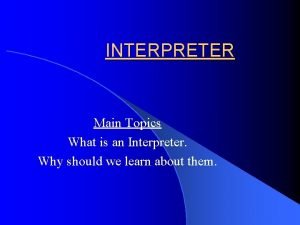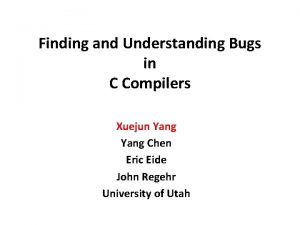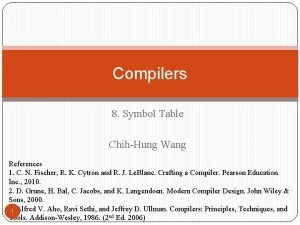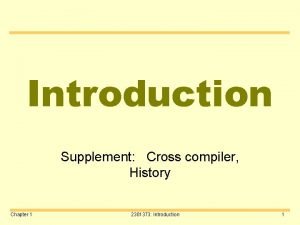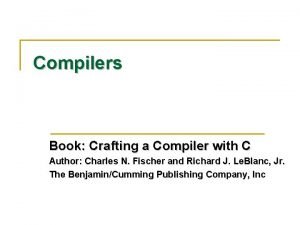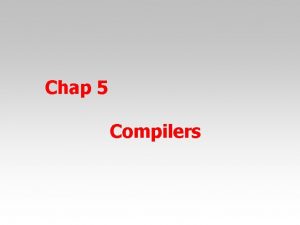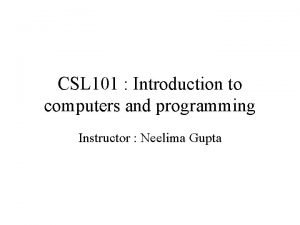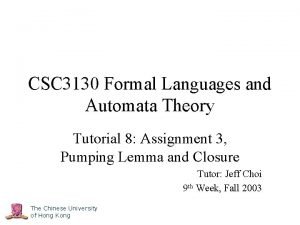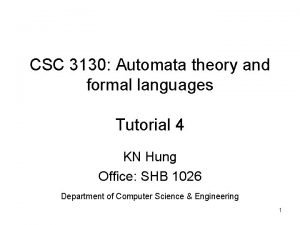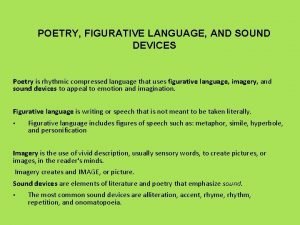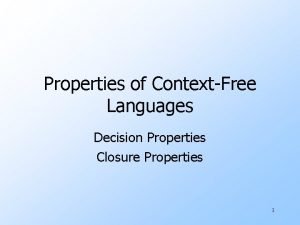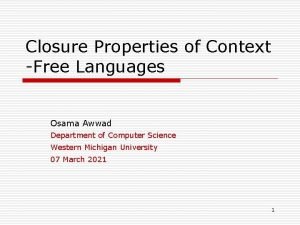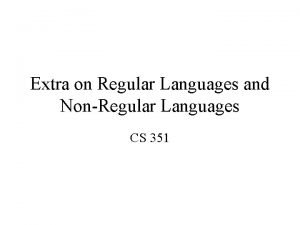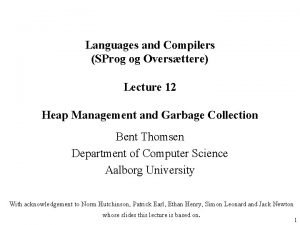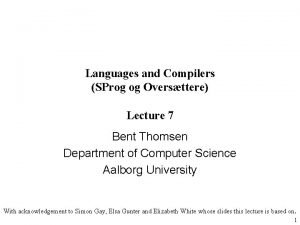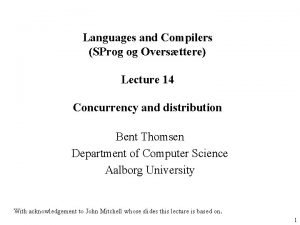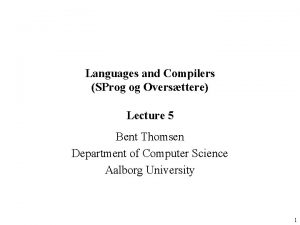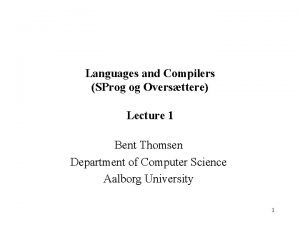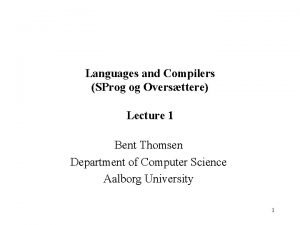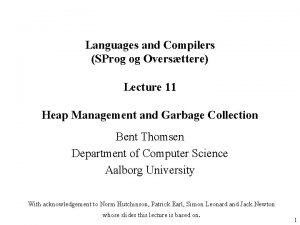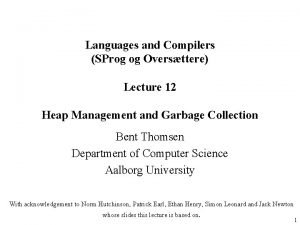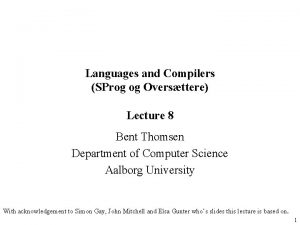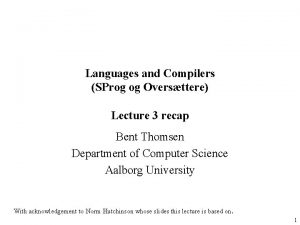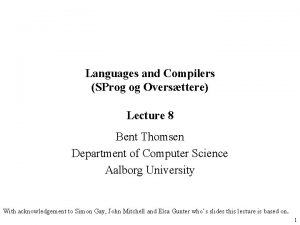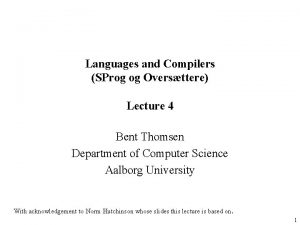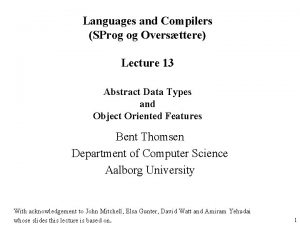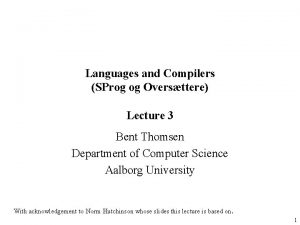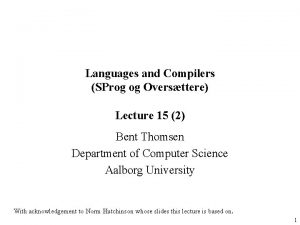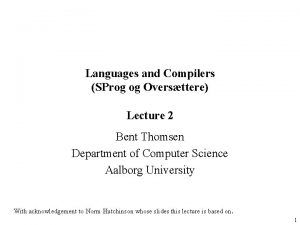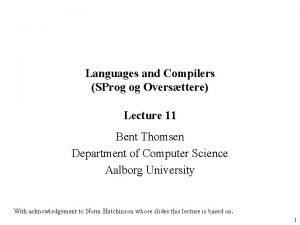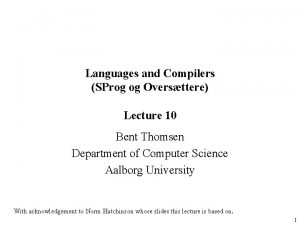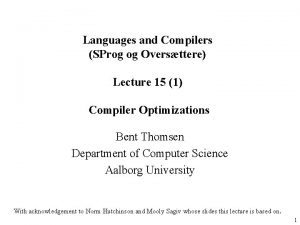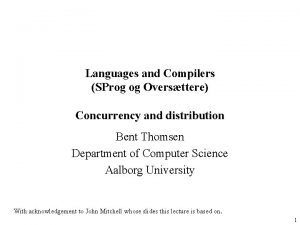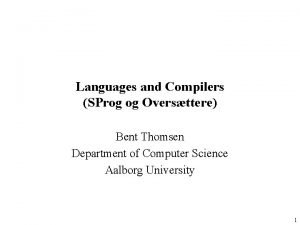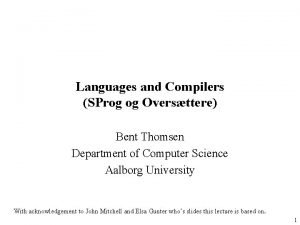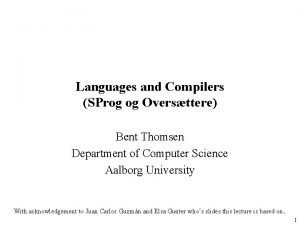Languages and Compilers SProg og Oversttere Lecture 9






![Interpretation • recursive interpretation – – operates directly on the AST [attribute grammar] simple Interpretation • recursive interpretation – – operates directly on the AST [attribute grammar] simple](https://slidetodoc.com/presentation_image/704f66a76c73d1a314da4bdb727012f6/image-7.jpg)



![Mini-Shell Interpreter Public class Mini. Shell. Command { public String name; public String[] args; Mini-Shell Interpreter Public class Mini. Shell. Command { public String name; public String[] args;](https://slidetodoc.com/presentation_image/704f66a76c73d1a314da4bdb727012f6/image-11.jpg)


























- Slides: 37

Languages and Compilers (SProg og Oversættere) Lecture 9 (1) Bent Thomsen Department of Computer Science Aalborg University With acknowledgement to Norm Hutchinson whose slides this lecture is based on. 1

The “Phases” of a Compiler Source Program Syntax Analysis Error Reports Abstract Syntax Tree Contextual Analysis Error Reports Decorated Abstract Syntax Tree Code Generation Next lecture Object Code 2

What’s next? • interpretation Source program front-end • code generation – code selection – register allocation – instruction ordering annotated AST interpreter Code generation Object code 3

What’s next? • intermediate code • interpretation Source program front-end • code generation – code selection – register allocation – instruction ordering annotated AST intermediate code generation interpreter Code generation Object code 4

Intermediate code • language independent – no structured types, only basic types (char, int, float) – no structured control flow, only (un)conditional jumps • linear format – Java byte code 5

The usefulness of Interpreters • Quick implementation of new language – Remember bootstrapping • • • Testing and debugging Portability via Abstract Machine Hardware emulation 6
![Interpretation recursive interpretation operates directly on the AST attribute grammar simple Interpretation • recursive interpretation – – operates directly on the AST [attribute grammar] simple](https://slidetodoc.com/presentation_image/704f66a76c73d1a314da4bdb727012f6/image-7.jpg)
Interpretation • recursive interpretation – – operates directly on the AST [attribute grammar] simple to write thorough error checks very slow: speed of compiled code 100 times faster • iterative interpretation – operates on intermediate code – good error checking – slow: 10 x 7

Iterative interpretation • Follows a very simple scheme: Initialize Do { fetch next instruction analyze instruction execute instruction } while (still running) • Typical source language will have several instructions • Execution then is just a big case statement – one for each instruction 8

Iterative Interpreters • Command languages • Query languages – SQL • Simple programming languages – Basic • Virtual Machines 9

Mini-Shell Script Command Argument Command-Name : : = | | | | Command* Command-Name Argument* end-of-line Filename Literal create delete edit list print quit Filename 10
![MiniShell Interpreter Public class Mini Shell Command public String name public String args Mini-Shell Interpreter Public class Mini. Shell. Command { public String name; public String[] args;](https://slidetodoc.com/presentation_image/704f66a76c73d1a314da4bdb727012f6/image-11.jpg)
Mini-Shell Interpreter Public class Mini. Shell. Command { public String name; public String[] args; } Public class Mini. Shell. State { //File store… public … //Registers public byte status; //Running or Halted or Failed public static final byte // status values RUNNING = 0, HALTED = 1, FAILED = 2; } 11

Mini-Shell Interpreter Public class Mini. Shell extends Mini. Shell. State { public void Interpret () { … // Execute the commands entered by the user // terminating with a quit command } public Mini. Shell. Command read. Analyze () { … //Read, analysze, and return //the next command entered by the user } public void create (String fname) { … // Create empty file wit the given name } public void delete (String[] fnames) { … // Delete all the named files } … public void exec (String fname, String[] args) { … //Run the executable program contained in the … //named files, with the given arguments } } 12

Mini-Shell Interpreter Public void interpret () { //Initialize status = RUNNING; do { //Fetch and analyse the next instruction Mini. Shell. Command com = read. Analyze(); // Execute this instruction if (com. name. equals(“create”)) create(com. args[0]); else if (com. name. equals(“delete”)) delete(com. args) else if … else if (com. name. equals(“quit”)) status = HALTED; else status = FAILED; } while (status == RUNNING); } 13

Hypo: a Hypothetic Abstract Machine • • 4096 word code store 4096 word data store PC: program counter, starts at 0 ACC: general purpose register 4 -bit op-code 12 -bit operand Instruction set: 14

Hypo Interpreter Implementation (1) 15

Hypo Interpreter Implementation (2) 16

TAM • The Triangle Abstract Machine is implemented as an iterative interpreter Take a look at the file Interpreter. java in the Triangle implementation. 17

Triangle Abstract Machine Architecture • TAM is a stack machine – There are no data registers as in register machines. – The temporary data are stored on the stack. • But, there are special registers (Table C. 1 of page 407) • TAM Instruction Set – Instruction Format (Figure C. 5 of page 408) – op: opcode (4 bits) • r: special register number (4 bits) • n: size of the operand (8 bits) • d: displacement (16 bits) • Instruction Set – Table C. 2 of page 409 18

TAM Registers 19

TAM Code • Machine code is 32 bits instructions in the code store – – op (4 bits), type of instruction r (4 bits), register n (8 bits), size d (16 bits), displacement • Example: LOAD (1) 3[LB]: – – op = 0 (0000) r = 8 (1000) n = 1 (00000001) d = 3 (000000011) • 0000 1000 0001 0000 0011 20

TAM Instruction set 21

TAM Architecture • Two Storage Areas – Code Store (32 bit words) • Code Segment: to store the code of the program to run – Pointed to by CB and CT • Primitive Segment: to store the code for primitive operations – Pointed to by PB and PT – Data Store (16 bit words) • Stack – global segment at the base of the stack » Pointed to by SB – stack area for stack frames of procedure and function calls » Pointed to by LB and ST • Heap – heap area for the dynamic allocation of variables » Pointed to by HB and HT 22

TAM Architecture 23

Global Variables and Assignment Commands • Triangle source code ! simple expression and assignment let var n: Integer in begin n : = 5; n : = n + 1 end • TAM assembler code 0: PUSH 1 1: LOADL 5 2: STORE (1) 0[SB] 3: LOAD (1) 0[SB] 4: LOADL 1 5: CALL add 6: STORE (1) 0[SB] 7: POP (0) 1 8: HALT 24

Recursive interpretation • Two phased strategy – Fetch and analyze program • Recursively analyzing the phrase structure of source • Generating AST • Performing semantic analysis – Recursively via visitor – Execute program • Recursively by walking the decorated AST 25

Recursive Interpreter for Mini Triangle Representing Mini Triangle values in Java: public abstract class Value { } public class Int. Value extends Value { public short i; } public class Bool. Value extends Value { public boolean b; } public class Undefined. Value extends Value { } 26

Recursive Interpreter for Mini Triangle A Java class to represent the state of the interpreter: public class Mini. Triangle. State { public static final short DATASIZE = …; //Code Store Program program; //decorated AST //Data store Value[] data = new Value[DATASIZE]; //Register … byte status; public static final byte //status value RUNNING = 0, HALTED = 1, FAILED = 2; } 27

Recursive Interpreter for Mini Triangle public class Mini. Triangle. Processer extends Mini. Triangle. State implements Visitor { public void fetch. Analyze () { //load the program into the code store after //performing syntactic and contextual analysis } public void run () { … // run the program public Object visit…Command (…Command com, Object arg) { //execute com, returning null (ignoring arg) } public Object visit…Expression (…Expression expr, Object arg) { //Evaluate expr, returning its result } public Object visit… } 28

Recursive Interpreter for Mini Triangle public Object visit. Assign. Command (Assign. Command com, Object arg) { Value val = (Value) com. E. visit(this, null); assign(com. V, val); return null; } public Objects visit. Call. Command (Call. Command com, Object arg) { Value val = (Value) com. E. visit(this, null); Call. Standard. Proc(com. I, val); return null; } public Object visit. Sequential. Command (Sequential. Command com, Object arg) { com. C 1. visit(this, null); com. C 2. visit(this, null); return null; } 29

Recursive Interpreter for Mini Triangle public Object visit. If. Command (If. Command com, Object arg) { Bool. Value val = (Bool. Value) com. E. visit(this, null); if (val. b) com. C 1. visit(this, null); else com. C 2. visit(this, null); return null; } public Object visit. While. Command (While. Command com, Object arg) { for (; ; ) { Bool. Value val = (Bool. Value) com. E. visit(this, null) if (! Val. b) break; com. C. visit(this, null); } return null; } 30

Recursive Interpreter for Mini Triangle public Object visit. Integer. Expression (Integer. Expression expr, Object arg){ return new Int. Value(Valuation(expr. IL)); } public Object visit. Vname. Expression (Vname. Expression expr, Object arg) { return fetch(expr. V); } … public Object visit. Binary. Expression (Binary. Expression expr, Object arg){ Value val 1 = (Value) expr. E 1. visit(this, null); Value val 2 = (Value) expr. E 2. visit(this, null); return apply. Binary(expr. O, val 1, val 2); } 31

Recursive Interpreter for Mini Triangle public Object visit. Const. Declaration (Const. Declaration decl, Object arg){ Known. Address entity = (Known. Address) decl. entity; Value val = (Value) decl. E. visit(this, null); data[entity. address] = val; return null; } public Object visit. Var. Declaration (Var. Declaration decl, Object arg){ Known. Address entity = (Known. Address) decl. entity; data[entity. address] = new Undefined. Value(); return null; } public Object visit. Sequential. Declaration (Sequential. Declaration decl, Object arg){ decl. D 1. visit(this, null); decl. D 2. visit(this, null); return null; } 32

Recursive Interpreter for Mini Triangle Public Value fetch (Vname vname) { Known. Address entity = (Known. Address) vname. visit(this, null); return data[entity. address]; } Public void assign (Vname vname, Value val) { Known. Address entity = (Known. Address) vname. visit(this, null); data[entity. address] = val; } Public void fetch. Analyze () { Parser parse = new Parse(…); Checker checker = new Checker(…); Storage. Allocator allocator = new Storage. Allocator(); program = parser. parse(); checker. check(program); allocator. allocate. Addresses(program); } Public void run () { program. C. visit(this, null); } 33

Recursive Interpreter and Semantics • Code for Recursive Interpreter is very close to a denotational semantics 34

Recursive Interpreters • Usage – Quick implementation of high-level language • LISP, SML, Prolog, … , all started out as interpreted languages – Scripting languages • If the language is more complex than a simple command structure we need to do all the front-end and static semantics work anyway. • Web languages – Java. Script, Ph. P, ASP where scripts are mixed with HTML or XML tags 35

Interpreters are everywhere on the web Web-Client HTML-Form (+Java. Script) Reply Web-Server Call PHP interpreter Submit Data Web-Browser WWW Response Database Server PHP Script Response LAN DBMS SQL commands Database Output 36

Interpreters versus Compilers Q: What are the tradeoffs between compilation and interpretation? Compilers typically offer more advantages when – programs are deployed in a production setting – programs are “repetitive” – the instructions of the programming language are complex Interpreters typically are a better choice when – – we are in a development/testing/debugging stage programs are run once and then discarded the instructions of the language are simple the execution speed is overshadowed by other factors • e. g. on a web server where communications costs are much higher than execution speed 37
 Cs 421 uiuc
Cs 421 uiuc Cs 421 programming languages and compilers
Cs 421 programming languages and compilers Motorik og sprog
Motorik og sprog Retoriske pentagram omstændigheder
Retoriske pentagram omstændigheder Prince black plus styrke
Prince black plus styrke Amalie skram novelle
Amalie skram novelle Pros and cons of compilers and interpreters
Pros and cons of compilers and interpreters Finding and understanding bugs in c compilers
Finding and understanding bugs in c compilers Lex leblanc
Lex leblanc Compiler and interpreter advantages and disadvantages
Compiler and interpreter advantages and disadvantages Compilers binarymove
Compilers binarymove Cousins of compiler
Cousins of compiler Compilers book
Compilers book Functions of compiler
Functions of compiler Front-end and back-end of compiler
Front-end and back-end of compiler 01:640:244 lecture notes - lecture 15: plat, idah, farad
01:640:244 lecture notes - lecture 15: plat, idah, farad Real-time systems and programming languages
Real-time systems and programming languages Languages for life and work
Languages for life and work What is media and information languages
What is media and information languages Proto language
Proto language Defence centre for languages and culture
Defence centre for languages and culture Difference between strongly and weakly typed languages
Difference between strongly and weakly typed languages Data mining primitives languages and system architecture
Data mining primitives languages and system architecture Storyboard about media and information literacy
Storyboard about media and information literacy Automata theory tutorial
Automata theory tutorial Automata theory tutorial
Automata theory tutorial Formal languages and automata theory tutorial
Formal languages and automata theory tutorial Advantages of high level language
Advantages of high level language Gtg stands for in automata
Gtg stands for in automata Sound device definition
Sound device definition Formal languages and automata theory tutorial
Formal languages and automata theory tutorial Csci3130
Csci3130 Real time programming language
Real time programming language Decision properties of context free languages
Decision properties of context free languages Context free language closure properties
Context free language closure properties Regular and irregular languages
Regular and irregular languages Translators and facilities of languages
Translators and facilities of languages Tandem language
Tandem language






